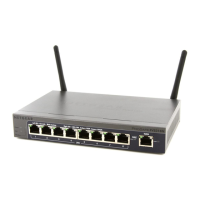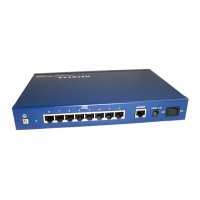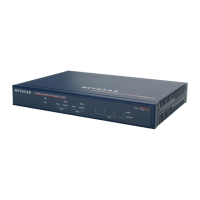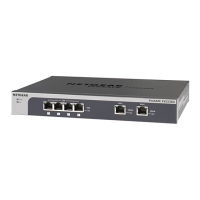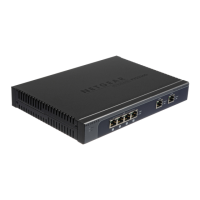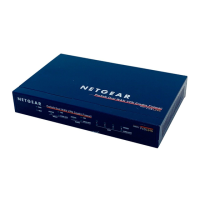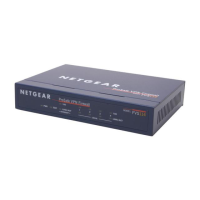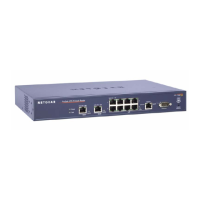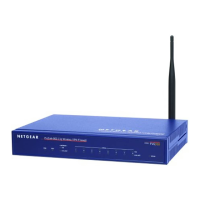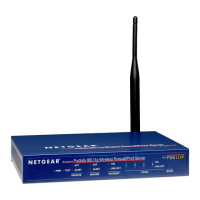Do you have a question about the NETGEAR FVS318G and is the answer not in the manual?
| Power requirements | 12V DC, 1.5A |
|---|---|
| Firewall throughput | 250 Mbit/s |
| Maximum data transfer rate | 1000 Mbit/s |
| HTTP performance | 6000 transactions/sec |
| Wi-Fi | No |
| DHCP server | Yes |
| Number of VLANs | 256 |
| VPN tunnels quantity | 12 |
| WAN connection | Ethernet (RJ-45) |
| Connectivity technology | Wired |
| Ethernet LAN (RJ-45) ports | 9 |
| Ethernet DMZ ports quantity | 1 |
| Routing protocols | RIP-1, RIP-2 |
| Supported network protocols | TCP/IP, UDP, ICMP, PPPoE |
| VPN support | IPsec (ESP), IKE, PKI, HTTPS |
| Security algorithms | 128-bit AES, 192-bit AES, 256-bit AES, 3DES, DES, MD5, SHA-1 |
| Internal memory | 128 MB |
| Flash memory | 32 MB |
| Storage media type | Flash |
| Processor frequency | 300 MHz |
| Storage temperature (T-T) | -20 - 70 °C |
| Operating temperature (T-T) | 0 - 45 °C |
| Cables included | LAN (RJ-45) |
| Weight | 590 g |
|---|---|
| Dimensions (WxDxH) | 190 x 125 x 35 mm |
Overview of the NETGEAR ProSAFE VPN Firewall FVS318G v2, its features, and capabilities.
Details the main features and capabilities of the VPN firewall, including ports, VPN support, and management.
Step-by-step guide on how to access and log into the VPN firewall's web management interface.
Overview of tasks required for Internet connection setup, depending on IPv4 or IPv6.
Steps to set up an IPv4 Internet connection, including WAN mode and connection type.
Steps to set up an IPv6 Internet connection, including WAN mode and connection type.
Guide to automatically detect and configure the WAN port for an IPv4 Internet connection.
Steps to manually configure IPv4 broadband ISP settings using information from the ISP.
Steps to autoconfigure IPv6 ISP settings using stateless or stateful address autoconfiguration.
Guide to manually configure a static IPv6 Internet connection using ISP-provided information.
Instructions for setting up a PPPoE IPv6 Internet connection with ISP-provided information.
Covers managing IPv4 Virtual LANs, DHCP options, and VLAN configurations.
Procedure to add, edit, or delete VLAN profiles for network segmentation.
Configuration options for the IPv6 DHCPv6 server (Stateless, Stateful, Prefix Delegation).
Steps to configure the IPv6 LAN settings, including IP address and prefix length.
Setting up the DMZ port for IPv4 and IPv6 traffic, including address and prefix length.
Enabling and configuring the DMZ port with an IPv4 address and subnet mask.
Enabling and configuring the DMZ port with an IPv6 address and prefix length.
Adding static routes to provide additional routing information to the VPN firewall.
Manual configuration of static IPv6 routes for routers to exchange routing information.
Setting up QoS to prioritize network traffic and ensure service quality.
Explanation of firewall functions, protection mechanisms, and how it separates networks.
Explains firewall rules for blocking or allowing specific traffic types and their configurations.
Steps to create and manage LAN to WAN firewall rules for outbound and inbound traffic.
Managing firewall rules for traffic between the DMZ and the Internet (outbound and inbound).
Creating rules for traffic movement between the local LAN and the DMZ network.
Guides through configuring multiple gateway or client VPN tunnel policies using the IPSec VPN Wizard.
Step-by-step procedure to set up an IPv4 gateway-to-gateway VPN tunnel using the VPN Wizard.
Procedure to set up an IPv6 gateway-to-gateway VPN tunnel using the VPN Wizard.
Steps to set up a client-to-gateway VPN tunnel using the VPN Wizard.
Guide to creating a secure VPN connection using the NETGEAR VPN Client Configuration Wizard.
Specifies the settings for Phase 1 authentication in the VPN client configuration.
Defines the Phase 2 settings for the IPSec configuration within the VPN client.
Sets global parameters for the VPN client, including lifetimes and DPD settings.
Setting up the L2TP server to allow users to access L2TP clients over L2TP tunnels.
Procedures to establish and test a VPN connection from the client to the firewall.
Editing, enabling, disabling, or deleting existing VPN and IKE policies.
Creating and managing VPN policies, including Auto and Manual methods.
Enabling and configuring XAUTH for user authentication via User Database, RADIUS, or IPSec Host.
Steps to manage domains, groups, and user accounts for authentication and access control.
Creating user accounts and assigning them to groups for authentication.
Using digital certificates for authenticating VPN gateways and clients.
Controlling traffic through the firewall to optimize performance and prevent bottlenecks.
Configuring the DMZ port for hosting servers and providing public access to services.
Shifting traffic mix using QoS priority and bandwidth profiles for optimum performance.
Managing system features like passwords, remote access, CLI, SNMP, configuration files, and firmware.
Modifying administrator and guest passwords, and configuring idle time-out settings.
Saving, restoring, clearing, or upgrading the VPN firewall's configuration file.
Resetting the VPN firewall to its original factory default settings.
Installing a different version of the VPN firewall firmware for new features or fixes.
Setting up the firewall to log events and send alerts via email or to a syslog server.
Tools for analyzing network and traffic conditions, including ping, traceroute, and packet capture.
Verifying the correct sequence of events during the VPN firewall's power-on sequence.
Steps to resolve issues when the web management interface is inaccessible.
Steps to determine if the VPN firewall can obtain a WAN IP address from the ISP.
Resolving difficulties connecting over an IPv6 connection due to misconfiguration.
Resetting the VPN firewall to its original factory default settings and password.
Details the factory default configuration settings for the VPN firewall.

